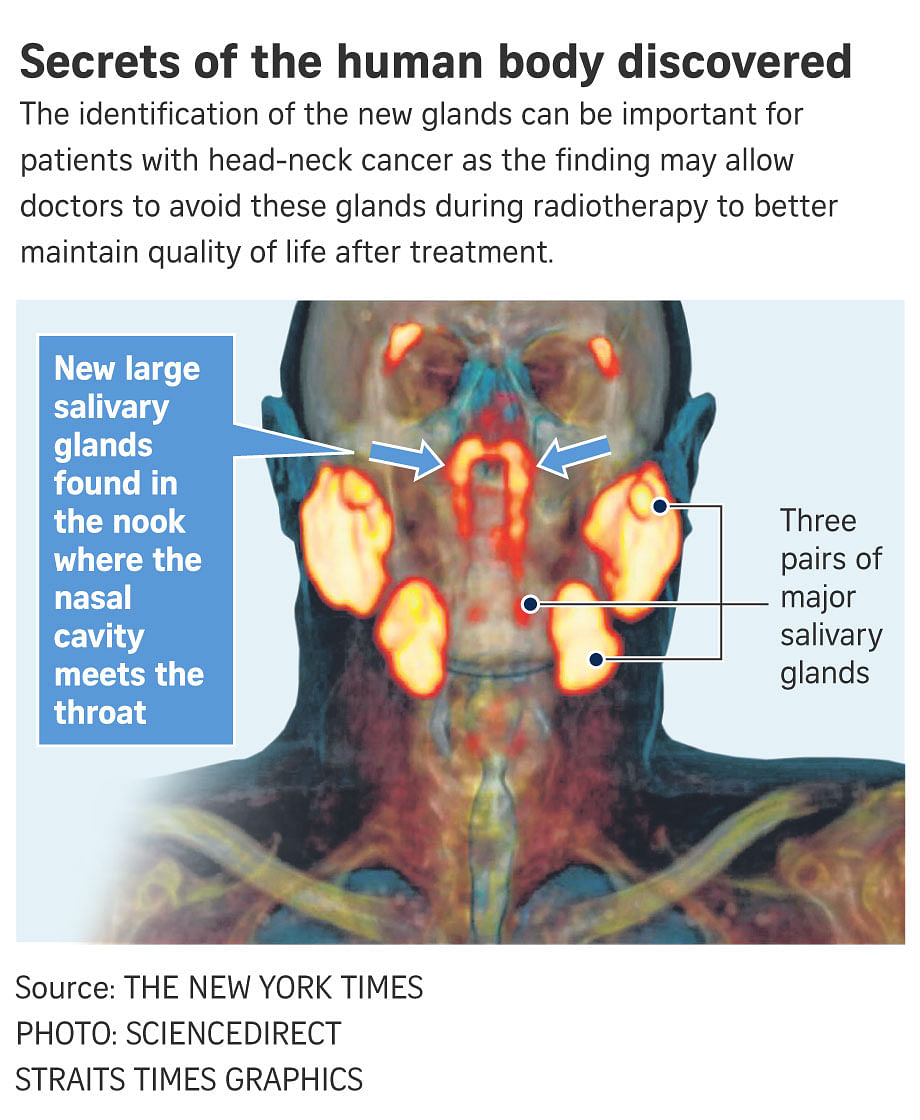NEW YORK • After millennia of careful slicing and dicing, it might seem as though scientists have figured out human anatomy.
A few dozen organs, a couple of hundred bones and connective tissue to tie it all together. But despite numerous centuries of scrutiny, the body is still capable of surprising scientists.
A team of researchers in the Netherlands has discovered what may be a set of previously unidentified organs: a pair of large salivary glands, lurking in the nook where the nasal cavity meets the throat.
If the findings are confirmed, this hidden wellspring of spit could mark the first identification of its kind in about three centuries.
Any modern anatomy book will show just three pairs of major salivary glands: one set near the ears, another below the jaw and another under the tongue.
"Now, we think there is a fourth," said Dr Matthijs Valstar, a surgeon and researcher at the Netherlands Cancer Institute and an author on the study, published last month in the journal Radiotherapy And Oncology.
The study was small, and examined a limited patient population, said Dr Valerie Fitzhugh, a pathologist at Rutgers University who was not involved in the research. But "it seems like they may be onto something", she said. "If it's real, it could change the way we look at disease in this region."
Even without a direct therapeutic application, Dr Yvonne Mowery, a radiation oncologist at Duke University, said she "was quite shocked that we are in 2020 and have a new structure identified in the human body".
Dr Valstar and his colleagues, who usually study data from people with prostate cancer, did not set out on a treasure hunt for unidentified spit glands. But the structures are important to researchers and doctors who deal in oncology.
Salivary glands collectively churn out about a quart (about 1,000ml) of spit each day, which is responsible for "a lot of things that make you enjoy life", Dr Valstar said.
It lubricates the mouth, making it easier to speak and swallow. It ferries the tasty chemicals in food to the microscopic cells that can sense them. It even comes imbued with crude healing powers, waging war against germs and speeding the closure of wounds.

Doctors take numerous precautions to avoid damaging the glands when administering radiation therapy, which can, with a single misdirected zap, permanently compromise the delicate tissues.
While perusing a set of scans from a machine that could visualise tissues in high detail, the researchers noticed two unfamiliar structures dead centre in the head: a duo of flat, spindly glands, a couple of inches (about 5cm) in length, draped discreetly over the tubes that connect the ears to the throat.
Puzzled by the images, they dissected tissue from two cadavers and found that the glands bore similarities to known salivary glands that sit below the tongue.
The new glands were also hooked up to large draining ducts - a hint that they were funnelling fluid from one place to another.
It is not completely clear how the glands eluded anatomists all this while. But "the location is not very accessible, and you need very sensitive imaging to detect it", said Dr Wouter Vogel, a radiation oncologist at the Netherlands Cancer Institute and an author on the study.
The new find, Dr Vogel said, might help explain why people who undergo radiation therapy for cancer of the head or neck so often end up with chronic dry mouth and swallowing problems. Because these obscure glands were not known to doctors, "nobody ever tried to spare them" from such treatments, Dr Vogel said.
NY TIMES

